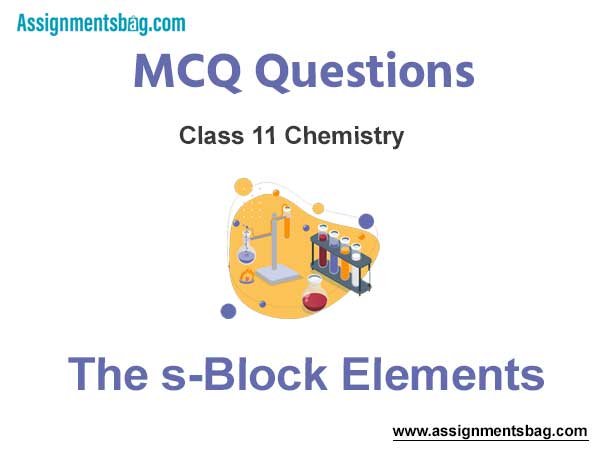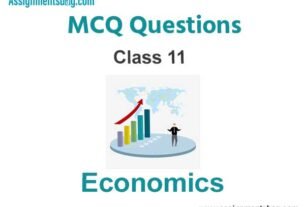Please refer to MCQ Questions Chapter 10 The s-Block Elements Class 11 Chemistry with answers provided below. These multiple-choice questions have been developed based on the latest NCERT book for class 11 Chemistry issued for the current academic year. We have provided MCQ Questions for Class 11 Chemistry for all chapters on our website. Students should learn the objective based questions for Chapter 10 The s-Block Elements in Class 11 Chemistry provided below to get more marks in exams.
Chapter 10 The s-Block Elements MCQ Questions
Please refer to the following Chapter 10 The s-Block Elements MCQ Questions Class 11 Chemistry with solutions for all important topics in the chapter.
MCQ Questions Answers for Chapter 10 The s-Block Elements Class 11 Chemistry
Question. Bleaching action of bleaching powder liberation of is due to the
(a) O2
(b) OCI–
(c) CI2
(d) CI–
Answer
C
Question. Beryllium and aluminium exhibit many properties which are similar. But, the two elements differ in
(a) exhibiting maximum covalency in compounds
(b) forming polymeric hydrides
(c) forming covalent halides
(d) exhibiting amphoteric nature in their oxides
Answer
A
Question. Bleaching powder is obtained by treating chlorine with
(a) CaCO3
(b) Ca(OH)
(c) Cao
(d) None of these
Answer
B
Question. For which one of the following minerals, the composition given is incorrect ?
(a) Glauber’s salt — Na2SO4 · 10H2O
(b) Borax — Na2B4O7 -7H2O
(c) Carnallite — KCI· MgCI2 · 6H2O
(d) Soda ash — Na2CO3
Answer
B
Question. The chemical formula offeldspar is
(a) KAISi3O8
(b) Na3AlF6
(c) NaAlO2
(d) K2SO4 ·Al2 (SO4)3 -4Al(OH)3
Answer
A
Question. The ionic mobility of alkali metal ions in aqueous solution is maximum for
(a) K+
(b) Rb+
(c) Li+
(d) Na+
Answer
B
Question. Na2S2O3 isreduced by I2 to
(a) Na2S
(b) Na2SO4
(c) NaHSO3
(d) Na2S4O6
Answer
D
Question. On strong heating sodium bicarbonate changes into
(a) sodium monoxide
(b) sodium hydroxide
(c) sodium carbonate
(d) sodium peroxide
Answer
C
Question. What happens when aluminium and zinc salts react with an excess of NaOH?
(a) White precipitate is fo1med
(b) White precipitate of both Zn and Al first formed redissolved in excess ofNaOH
(c) White precipitate of AI redissolves but that of Zn does not
(d) White precipitate of Zn redissolves and that of Al does not
Answer
B
Question. Which one of the following will dissolve in water most readily?
(a) I2
(b) BaCO3
(c) KF
(d) Pbl2
Answer
C
Question. Which compound is used in photography?
(a) Na2SO5
(b) Na2S2O8
(c) Na2S2O6
(d) Na2S2O3
Answer
D
Question. Sodium thiosulphate is a
(a) reducing agent
(c) complexing agent
(b) oxidising agent
(d) bleaching agent
Answer
A
Question. A metal ‘M’reacts with N2 to giveacomp01md ‘A’ (M3N). ‘A’ on heating at high temperature gives back ‘M’ and ‘A’ on reacting with H2O gives a gas B. ‘B’ turns CuSO4 solution blue on passing through it. M and B can be
(a) Al and NH3
(b) Li and NH3
(c) Na and NH3
(d) Mg and NH3
Answer
B
Question. Based on lattice energy and other considerations which one of the following alkali metal chlorides is expected to have the highest melting point ?
(a) RbCI
(b) KCl
(c) NaCl
(d) LiCl
Answer
C
Question. Solvay process is used for the manufacture of
(a) NaOH
(b) Na2CO3
(c) NH3
(d) NaCl
Answer
B
Question. One of the elements present in camallite shows flame colouration. The colour of the flame is
(a) orange
(b) green
(c) yellow
(d) lilac
Answer
D
Question. Which of the following alkali metal ions has lowest ionic mobility in aqueous solution?
(a) Rb+
(b) Cs+
(c) Li+
(d) Na+
Answer
C
Question. The ionic conductance of following cation in a given concentration are in the order
(a) Li+ < Na+ < K+ < Rb+
(b) Li+ > Na+ > K+ > Rb+
(c) Li+ < Na+ > K+ > Rb+
(d) Li+ = Na+ < K+ < Rb+
Answer
A
Question. A metallic oxide reacts with water to fonn its hydroxide, hydrogen peroxide and also liberates oxygen. The metallic oxide could be
(a) Cao
(b) KO2
(c) Li2O
(d) Na2O2
Answer
B
Question. What colour is imparted into the flame when lithium is burnt?
(a) Golden yellow
(b) Brick red
(c) Crimson red
(d) Grassy green
Answer
C
Question. Lithium shows diagonal relationship with
(a) sodium
(b) magnesium
(c) calcium
(d) aluminimn
Answer
B
Question. All the s-block elements of the periodic table and placed in the groups
(a) IA and II A
(b) III A and IV A
(c) B subgroups
(d) VA to VII A
Answer
A
Question. Which of the following is known as Glauber’s salt?
(a) Na2S2O3 ·5H2O
(c) Na2CO3 · 10H2O
(b) Na2SO4 · 10H2O
(d) Na(NH4)HPO4
Answer
B
Question. Le-blanc process is employed in the manufacture of
(a) baking soda
(b) washing soda
(c) potash
(d) plaster of Paris
Answer
C
Question. The characteristic not related to alkali metal is
(a) high ionisation energy
(b) their ions are isoelectronic with noble gases
(c) low melting point
(d) low electronegativity
Answer
A
Question. The products obtained on heating LiNO3 will be
(a) LiNO2 + O2
(b) Li2O + NO2 + O2
(c) Li3N + O2
(d) Li2O + OH + O2
Answer
B
Question. The primary standard solution for the estimation of Na2S2O3 is
(a) I2 solution
(c) K2Cr2O7
(b) KMnO4
(d) oxalic acid
Answer
A
Question. Which one of the following statements is correct for all the alkali metals?
(a) Their nitrates on heating give NO2 and O2
(b) Their carbonates decompose on heating to give CO2 and the metal oxide
(c) They react with oxygen to give mainly the oxide M2O
(d) They react with halogens to give the halides MX
Answer
D
Question. Acidic solution of S2O2-3 is converted to …… in the presence of I2 .
(a) S4O62- + I–
(b) SO42- + I–
(c) SO3 + I–
(d) S4O62- + I3–
Answer
A
Question. Sodium is heated in air at 300°C to form X. X absorbs CO2 and forms Na2CO3 and Y? Which of the following is Y?
(a) H2
(b) O2
(c) H2O2
(d) O3
Answer
B
Question. Which of the following is not correct?
(a) Iodine oxidises sodium thiosulphate to sodium tetrathionate
(b) Sodium thiosulphate is soluble in water
(c) Ozone is used to identify the presence of unsaturation in alkenes
(d) Sodium thiosulphate reacts with iodine to form sodium sulphate
Answer
D
Question. Most powerful reducing agent is
(a) Li
(b) Na
(c) Ca
(d) Mg
Answer
A
Question. The difference of water molecules in gypsum and plaster of Paris is
(a) 5/2
(b) 2
(c) 1/2
(d) 1 1/2
Answer
D
Question. Which of the following is known as dead burnt plaster?
(a) Gypsum
(b) Plaster of Paris
(c) Anhydrite
(d) None of the above
Answer
C
Question. CaC2 + N2 → A,productA is
(a) CaCN2
(b) CaCN2 + C
(c) CaCN2 + N2
(d) None of these
Answer
B
Question. Among the following, which is insoluble in water?
(a) Sodium fluoride
(b) Potassium fluoride
(c) Beryllium fluoride
(d) Magnesium fluoride
Answer
D
Question. Which one of the following processes is used for the manufacture of calcium?
(a) Reduction of CaO with carbon
(b) Reduction of CaO with hydrogen
(c) Electrolysis ofa mixture of anhydrous CaCI2 and KCI
(d) Electrolysis of molten Ca(OH)2
Answer
C
Question. The chemical which is used for plastering the broken bones is
(a) (CaSO4 )2· H2O
(b) MgSO4 · 7H2O
(c) FeSO4 · 7H2O
(d) CuSO4 · 5H2O
Answer
A
Question. Which one of the following orders of stability is correct?
(a) MgCO3 > CaCO3 > SrCO3 > BaCO3
(b) BaCO3 > SrCO3 > CaCO3 > MgCO3
(c) MgCO3 > BaCO3 > SrCO3 > CaCO3
(d) CaCO3 > BaCO3 > MgCO3 > SrCO3
Answer
B
Question. Chlorine reacts with ‘X’ to form bleaching powder. ‘X’ is
(a) dry slaked lime
(c) acetone
(b) sodium hydroxide
(d) chloral
Answer
A
Question. The element which on burning in air gives peroxide is
(a) lithium
(b) sodium
(c) rubidium
(d) caesium
Answer
B
Question. Plaster of Paris on making paste with little water sets to hard mass due to formation of
(a) CaSO4
(b) CaSO4 · 1/2 H2O
(c) CaSO4 · H2O
(d) CaSO4 · 2H2O
Answer
D
Question. One mole of magnesium nitride on the reaction with an excess of water gives
(a) one mole of NH3
(b) two moles of NH3
(c) one mole of HNO3
(d) two moles of HNO3
Answer
B
Question. When carbon monoxide is passed over solid caustic soda heated to 200°C, it forms
(a) Na2CO3
(b) NaHCO3
(c) HCOONa
(d) CH3COONa
Answer
C
Question. Aqueous solution of Na2S2O3 on reaction with Cl2 gives
(a) Na2S4O6
(b) NaHSO4
(c) NaCl
(d) NaOH
Answer
B
Question. Which of the following metals is extracted by the electrometallmgical method ?
(a) Fe
(b) Cu
(c) Ni
(d) Na
Answer
D
Question. Molten sodium chloride conducts electricity through the following
(a) free electrons
(b) free ions
(c) free molecules
(d) free atoms
Answer
B
Question. When KI is added to acidified solution of sodium nitrite then
(a) NO gas is liberated and I2 is set free
(b) N2 gas is liberated and HI is produced
(c) N2Ogas is liberated and I2 is set free
(d) N2 gas is liberated and HOI is produced
Answer
A
Question. Microcosmic salt is
(a) Na4P2O7
(b) Na (NH4)HPO4
(c) Na (NH3)HPO4 ·4H2O
(d) MgNH4PO4
Answer
B
Question. A solution of sodium thiosulphate on addition of few drops of ferric chloride gives violet colom due to the formation of
(a) Na2S4O6
(b) Fe2 (SO4)3
(c) Fe2 (S2O3)3
(d) Fe2 (S2O3)2
Answer
C
Question. Which of the following is correct ?
(a) In the Castner’s process of sodium extraction, NaCl is used as an electro! yte
(b) Sodium reduces CO2 to carbon
(c) Mg reacts with cold water and liberate hydrogen gas.
(d) Magnalium is an alloy of Mg and Zn
Answer
B
Question. Consider the following abbreviations for hydrated alkali ions.
X = [Li(H2O)n]+; Y = [K(H2O)n]+; Z = [Cs (H2O)n]+
What is the con-ect order of size of these hydrated alkali ions ?
(a) X > Y > Z
(b) Z > Y > X
(c) X = Y = Z
(d) Z > X > Y
Answer
A
Question. Phosphine, acetylene and ammonia can be formed by treating water with
(a) Mg2P2 , Al4C3 , Li3N
(b) Ca3P2 , CaC2 , Mg3N2
(c) Ca3P2 , CaC2 , CaCN2
(d) Ca3P2 , Mg2C, NH4NO3
Answer
C
Question. Which of the following metal carbonates decomposes on heating?
(a) MgCO3
(b) Na2CO3
(c) K2CO3
(d) Rb2CO3
Answer
A
Question. The salts of which alkaline earth metal are used in the form of manure ?
(a) Mg
(b) Ca
(c) Ba
(d) Sr
Answer
B
Question. Which of the following is not an ore of magnesium?
(a) Carnalli te
(c) Calamine
(b) Dolomite
(d) Sea water
Answer
C
Question. Thomas slag is
(a) Ca3 (PO4 )2 · 2H2O
(b) Ca3 (PO4 )2 · CaSiO3
(c) MgSiO3
(d) CaSiO3
Answer
B
Question. The product obtained on fusion of BaSO4 and Na2CO3 is
(a) BaCO3
(b) Bao
(c) Ba(OH)2
(d) BaHSO4
Answer
A
Question. Which metal is present in chlorophyll?
(a) Ca
(b) Co
(c) Zn
(d) Mg
Answer
D

We hope you liked the above provided MCQ Questions Chapter 10 The s-Block Elements Class 11 Chemistry with solutions. If you have any questions please ask us in the comments box below.


